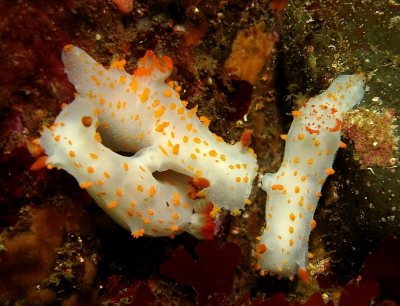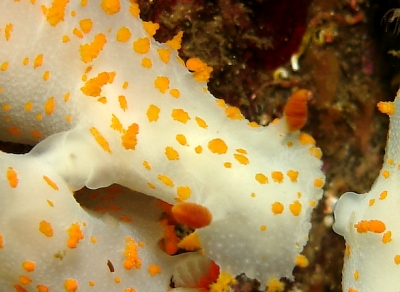Re: Mating Triopha catalinae from Canada
July 14, 2008
From: Glen Miller

Concerning message #14241:
Thought this additional photo of mating Triopha catalinae may be of interest seen the 3rd animal extending its mating tube (what is the proper anatomical name for this structure?)
Locality: NW Coast, Vancouver Island, 50 feet, British Columbia, Canada, Pacific Ocean, 06 July 2008, Wall . Length: 12 cm. Photographer: Glen Miller.
Glen Miller
earthlingenterprises@telus.net
Miller, G., 2008 (Jul 14) Re: Mating Triopha catalinae from Canada. [Message in] Sea Slug Forum. Australian Museum, Sydney. Available from http://www.seaslugforum.net/find/21683
Thanks Glen,
Your question is an interesting one. The answer is complicated because firstly, as you know, these animals have a full set of male and female organs and secondly, the actual copulatory organs are in a different place when they are functioning than they are the rest of the time. To keep it as simple as possible I will just deal with Triopha, and related nudibranchs in which both male and female organs are found in much the same part of the body. When you dissect a preserved Triopha there is a genital pore on the right side of the body which opens into a small sac, which is called the genital vestibule. There are three openings into this sac, one of which is the male penial opening, and the other two are female openings, one which receives the penis of the partner, and the other which deposits the fertilised eggs in the typical egg ribbon. It's hard to call one of these the vagina, as in mammals there is a single duct which performs both these functions. So the first problem is what to call the ducts. The second problem is that things look quite different during copulation. The genital vestibule turns inside out so that what is a sac in a preserved, or non-mating animal, is a raised 'tube' as you described, in a mating animal. The penial opening effectively disappears as a hole, because the penial apparatus which has been tucked inside the body cavity is pushed out so that it can enter the appropriate female duct of its partner.
I tend to skirt around the problem by talking about the everted genital organs or genital apparatus. There is no problem talking about the everted penis, but in species like Triopha with two female openings, calling the opening that the penis enters the vagina, leaves the 'egg duct' without a name. There are other dorids and nudibranchs in which there is only one female duct. In those cases, calling the common female duct the vagina seems perfectly appropriate. I know this doesn't give you a satisfactory answer - perhaps if you want a descriptive term to describe what you can see in the photo, ' everted mating organs' is the answer, because it could apply to nudibranchs with one or two female genital ducts.
Best wishes,
Bill Rudman
Related messages
-
Mating Triopha catalinae from Canada
From: Paul Sim, July 13, 2005 -
Brownish colour form of Triopha catalinae
From: Paul Sim, May 10, 2005 -
Triopha catalinae from California
From: Bruce Wight, August 9, 2004 -
Clown slugs
From: Jimmy, February 4, 2004 -
Triopha catalinae laying eggs
From: Ken Ashman, November 27, 2003 -
Triopha catalinae from Channel Ids, California
From: Bruce Wight, August 4, 2003 -
Juvenile Triopha catalinae? from Brit. Columbia
From: Marli Wakeling, October 8, 2002 -
Re: Triopha catalinae from Korea
From: Dave Behrens, July 10, 2002 -
Triopha catalinae from Sth Korea
From: Dong Bum, Koh, July 6, 2002 -
Triopha catalinae from California
From: Ken Tucker, July 20, 2001 -
Triopha catalinae from Los Angeles
From: Daniel Geiger, July 20, 2001 -
Triopha catalinae from British Columbia
From: Marli Wakeling, June 4, 2000 -
Cnidosacs in Triopha catalinae
From: Ryan Murphy, April 16, 2000 -
Triopha carpenteri
From: Nicole, December 23, 1999
